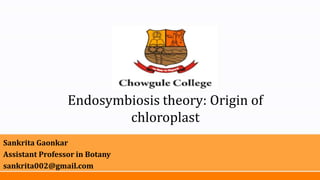
Endosymbiotic theory
- 1. Endosymbiosis theory: Origin of chloroplast Sankrita Gaonkar Assistant Professor in Botany sankrita002@gmail.com
- 2. Contents • Endosymbiosis theory • References
- 3. • Eukaryotic cells may have evolved when multiple cells joined together into one. • They began to live in symbiotic relationships. • Evidence Supports Endosymbiotic Theory • As early as 1883, botanist Andreas Schimper was looking at the plastid organelles of plant cells using a microscope. He watched the plastids divide and noticed something odd. The process looked very similar to the way some free-living bacteria divided. • During the 1950s and 60s, scientists found that both mitochondria and plastids inside plant cells had their own DNA. It was different from the rest of the plant cell DNA. When scientists looked closer at the genes in the mitochondrial and plastid DNA, they found that the genes were more like those from prokaryotes. This tells us that organelles are more closely related to prokaryotes
- 4. • The green chloroplasts in this cell are now a critical part of plant cells, but they evolved from an entirely different organism than the plant cell. The chloroplast is thought to have evolved from a cyanobacterial cell that managed to survive the cell's defenses.
- 5. Endosymbiotic theory • An endosymbiont is an organism that lives inside of another one benefiting each other • Endosymbiotic theory – A long time ago, a photosynthetic prokaryote was ingested by a larger one but it was not digested. It survived and it was trapped in the cytoplasm. This is called endosymbiosis, endo = inside, sym = together, bio = life, life living together inside. • A wide variety of evidences support the theory that small prokaryotes began living in larger host cells • The cells likely gained entry to the host as undigested prey or internal parasite • Photosynthetic endosymbiont provide nutrients to the heterotrophic host • Host provide shelter for the prokaryote • Over time, this relationship resulted in a situation where two parts became inseparable giving rise to a single organism
- 6. Evidences for endosymbiotic theory: • Chloroplast have their own circular DNA • Chloroplast is semiautonomous – self replicate – like prokaryotes • Inner membranes of chloroplast have enzymes and transport system similar to that of prokaryotes • Chloroplast are almost same size as prokaryotes • Chloroplast is sensitive to certain antibiotics • Chloroplast contains ribosomes that are more similar to bacterial ribosomes
- 7. Secondary endosymbiosis is another step in eukaryotic evolution • In this process, a heterotrophic eukaryote engulfed an unrelated photosynthetic eukaryote (plastid) • Plastids were ingested into the food vacuole, and over time formed a symbiotic relationship with the host • Heterotrophic eukaryotes engulfed green algae • Plastid are surrounded by 2 membranes: • Inner membrane derived from engulfed algal plasma membrane • Outer membrane derived from heterotrophic eukaryeic food vacuole
- 10. References • McFadden G. I. 2014. Origin and Evolution of Plastids and Photosynthesis in Eukaryotes. Cold Spring Harb Perspect Biol, 6:016105 • https://askabiologist.asu.edu/explore/cells-living-in-cells • https://royalsocietypublishing.org/doi/10.1098/rstb.2014.0330 • https://bio.libretexts.org/Bookshelves/Microbiology/Book%3A_Microbiolo gy_(Kaiser)/Unit_4%3A_Eukaryotic_Microorganisms_and_Viruses/07%3 A_The_Eukaryotic_Cell/7.8%3A_The_Endosymbiotic_Theory